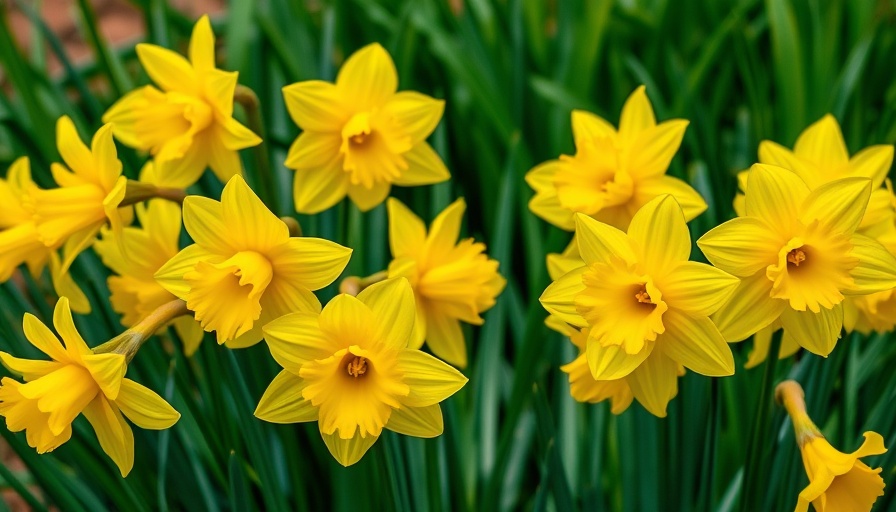
Understanding Daffodil Foliage: Why Yellowing Happens
Daffodils are among the first blooms of spring, heralding the season with vibrant colors and lush green foliage. However, when the foliage begins to turn yellow, it's a cause for concern among gardeners. While yellowing leaves in plants often signal distress, with daffodils, there are several factors that can contribute to this phenomenon. In this article, we'll dive into the common reasons why daffodil foliage turns yellow and explore preventive measures to maintain healthy blooms in your garden.
1. Basal Rot: The Fungal Threat
One of the most serious issues that can affect daffodils is basal rot, caused by the soil-borne fungus Fusarium oxysporum. This pathogen can wreak havoc, leading to the complete degradation of bulbs if not addressed early. Checking bulbs before planting is essential; if you spot any pinkish-white fungus or notice soft spots, it's crucial to avoid planting these damaged bulbs. Proper disposal and fungicide treatment for healthy bulbs will help prevent this destructive disease.
2. Sunlight Requirements: A Crucial Element for Growth
Daffodils thrive in sunny conditions, needing at least six hours of direct sunlight daily. If your daffodils are in full shade, this could be the reason for their yellowing leaves. Not only does inadequate sunlight affect blooming, but it can also stunt their growth. Consider relocating your bulbs to achieve better sunlight exposure, as this simple change can vastly improve their health.
3. Leaf Scorch: The Hidden Danger
Leaf scorch occurs when plants experience too much heat and insufficient water, leading to yellowing and crisping of the leaf edges. This stress can be exacerbated by extreme temperatures and drying winds, especially in early spring when daffodils are emerging. Ensuring adequate watering and protecting them from harsh environmental conditions can mitigate the risk of leaf scorch.
4. Maturity: A Natural Lifecycle
As daffodils mature, it's not uncommon for their foliage to yellow, signaling the end of their life cycle. This process is completely natural, particularly when the bloom period is over. During this phase, it's important to avoid cutting the leaves too early; they will continue to photosynthesize, providing energy back to the bulb for next year’s growth.
5. Narcissus Yellow Stripe Virus: A Serious Concern
The Narcissus yellow stripe virus can cause severe damage to daffodil plants, leading to yellowing and stunted growth. Infected plants may exhibit distinct yellow stripes on their leaves, which can diminish the overall vigor of the plant. If infestation is suspected, it’s critical to remove and destroy any visibly infected plants to prevent the spread of the virus in your garden.
6. Nutrient Deficiency: Feeding Your Daffodils
A lack of essential nutrients can lead to yellowing leaves, especially nitrogen, which is crucial for healthy green foliage. Ensuring your daffodils receive proper fertilization — following organic gardening practices or using compost — can enhance their nutrient intake. Conducting soil tests can also provide insight into necessary amendments, helping to nourish your flower garden.
7. Root Rot: The Importance of Drainage
Overwatering or poor drainage can lead to root rot, a dire condition that could turn daffodil leaves yellow. Ensuring proper soil drainage and allowing bulbs to dry out slightly between waterings can prevent root rot. When planting, consider mixing in organic matter to improve soil structure and drainage, thereby promoting bulb health.
Fostering Healthy Daffodils: Actionable Tips and Practices
With all these factors in mind, maintaining healthy daffodil foliage is within reach. Here are a few actionable tips:
- Regularly check your bulbs for signs of rot or fungus.
- Ensure they are planted in a location where they receive sufficient sunlight.
- Monitor watering practices closely to avoid both drought and overwatering.
- Foster soil health through organic fertilizers and composting.
- Be vigilant against pests and diseases, removing infected plants promptly.
By staying informed about these common challenges, you can ensure your daffodil foliage remains vibrant and your garden thrives.
Engage with the nuances of plant care and remember—gardening is as much about nurturing knowledge as it is about nurturing plants. Happy gardening!
 Add Row
Add Row  Add
Add 




Write A Comment